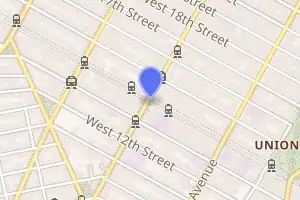14th Street/Sixth Avenue station
14th Street/Sixth Avenue is an underground New York City Subway station complex in the Chelsea district of Manhattan on the IRT Broadway–Seventh Avenue Line, the BMT Canarsie Line and the IND Sixth Avenue Line. It is located on 14th Street between Sixth Avenue (Avenue of the Americas) and Seventh Avenue. It is served by the:
- 1, 2, F, and L trains at all times
- 3 train at all times except late nights
- M train during weekdays
- <F> train during rush hours in the peak direction
14 Street/6 Avenue | |||||||||||||
|---|---|---|---|---|---|---|---|---|---|---|---|---|---|
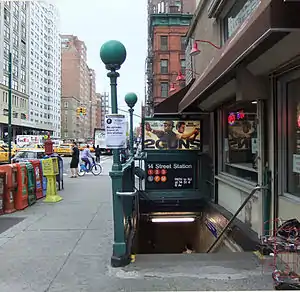 Entrance looking west at 7th Avenue and 14th Street NW street stair | |||||||||||||
| Station statistics | |||||||||||||
| Address | West 14th Street, Sixth & Seventh Avenues New York, NY 10011 | ||||||||||||
| Borough | Manhattan | ||||||||||||
| Locale | Chelsea, Greenwich Village, Union Square | ||||||||||||
| Coordinates | 40.737328°N 73.996796°W | ||||||||||||
| Division | A (IRT), B (BMT, IND) | ||||||||||||
| Line | IRT Broadway–Seventh Avenue Line BMT Canarsie Line IND Sixth Avenue Line | ||||||||||||
| Services | 1 2 3 F L M | ||||||||||||
| Transit | |||||||||||||
| Levels | 3 | ||||||||||||
| Other information | |||||||||||||
| Opened | July 1, 1918 (Seventh Avenue Line platforms) September 24, 1924 (Canarsie Line platform) December 15, 1940 (Sixth Avenue Line platforms) | ||||||||||||
| Station code | 601[1] | ||||||||||||
| Accessible | not ADA-accessible; accessibility planned | ||||||||||||
| Traffic | |||||||||||||
| 2019 | 14,736,035[2] | ||||||||||||
| Rank | 17 out of 424[2] | ||||||||||||
| |||||||||||||
| |||||||||||||
| |||||||||||||
A connection is available from this complex to the PATH station at 14th Street and Sixth Avenue. There is a direct passageway from this complex to the PATH station's southbound platform; transferring between this complex and the northbound PATH platform requires exiting onto street level first.
History
Broadway–Seventh Avenue Line
The Dual Contracts, which were signed on March 19, 1913, were contracts for the construction and/or rehabilitation and operation of rapid transit lines in the City of New York. The contracts were "dual" in that they were signed between the City and two separate private companies (the Interborough Rapid Transit Company and the Brooklyn Rapid Transit Company), all working together to make the construction of the Dual Contracts possible. The Dual Contracts promised the construction of several lines in Brooklyn. As part of Contract 4, the IRT agreed to build a branch of the original subway line south down Seventh Avenue, Varick Street, and West Broadway to serve the West Side of Manhattan.[3][4][5]
The construction of this line, in conjunction with the construction of the Lexington Avenue Line, would change the operations of the IRT system. Instead of having trains go via Broadway, turning onto 42nd Street, before finally turning onto Park Avenue, there would be two trunk lines connected by the 42nd Street Shuttle. The system would be changed from looking like a "Z" system on a map to an "H" system. One trunk would run via the new Lexington Avenue Line down Park Avenue, and the other trunk would run via the new Seventh Avenue Line up Broadway. In order for the line to continue down Varick Street and West Broadway, these streets needed to be widened, and two new streets were built, the Seventh Avenue Extension and the Varick Street Extension.[6] It was predicted that the subway extension would lead to the growth of the Lower West Side, and to neighborhoods such as Chelsea and Greenwich Village.[7][8]
14th Street opened as the line was extended south to South Ferry from 34th Street–Penn Station on July 1, 1918, and was served by a shuttle.[9] The new "H" system was implemented on August 1, 1918, joining the two halves of the Broadway–Seventh Avenue Line and sending all West Side trains south from Times Square.[10] An immediate result of the switch was the need to transfer using the 42nd Street Shuttle. The completion of the "H" system doubled the capacity of the IRT system.[7]
Canarsie Line
Sixth Avenue on the BMT Canarsie Line opened on June 30, 1924, as the terminal of the 14th Street–Eastern Line, which ran from Sixth Avenue under the East River and through Williamsburg to Montrose and Bushwick Avenues.[11][12]
Sixth Avenue Line
14th Street is a local station on the IND Sixth Avenue Line that opened on December 15, 1940, along with the rest of the IND Sixth Avenue Line from West Fourth Street–Washington Square to 47th–50th Streets–Rockefeller Center.[13]
Consolidation as a station complex
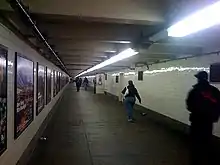
On January 16, 1978, a free transfer passageway connecting the 14th Street station on the IRT Broadway-Seventh Avenue Line and the stations on the BMT Canarsie Line and the IND Sixth Avenue Line opened.[14]
The entire station complex except for the PATH station will receive elevators in 2020–2022.[15] Originally, the improvements were scheduled for the Sixth Avenue and Canarsie Lines only.[16][17]
Station layout
| G | Street level | Exit/entrance |
| B1 | Mezzanine | Fare control, station agent, transfers between services |
| B2 Broadway–Seventh Avenue platforms |
Northbound local | ← ← |
| Island platform | ||
| Northbound express | ← ← | |
| Southbound express | | |
| Island platform | ||
| Southbound local | | |
| B2 Sixth Avenue and PATH platforms |
Northbound local | ← ← |
| Side platform | ||
| Side platform | ||
| Northbound | ← HOB–33 weekdays toward 33rd Street (23rd Street) ← JSQ–33 (via HOB weekends) toward 33rd Street (23rd Street) | |
| Southbound | HOB–33 weekdays toward Hoboken (9th Street) → JSQ–33 (via HOB weekends) toward Journal Square (9th Street) → | |
| Side platform | ||
| Side platform | ||
| Southbound local | | |
| B3 Canarsie platform |
Westbound | ← |
| Island platform | ||
| Eastbound | | |
| B4 | Northbound express | ← |
| Southbound express | | |
- The IRT Broadway–Seventh Avenue Line platforms and the other lines' platforms are one block apart.
- The express tracks of the IND Sixth Avenue Line run under the complex but are not part of the station.[18]
- The PATH platforms are at 14th Street and Sixth Avenue, between the IND Sixth Avenue Line platforms, but require a separate fare payment.
IRT Broadway–Seventh Avenue Line platforms
14 Street | |||||||||||||||||||||||||||||||||||||||||||||||||||||||||||||||||||||||||||||||||||||||||||||||||||||||||||||||||||||
|---|---|---|---|---|---|---|---|---|---|---|---|---|---|---|---|---|---|---|---|---|---|---|---|---|---|---|---|---|---|---|---|---|---|---|---|---|---|---|---|---|---|---|---|---|---|---|---|---|---|---|---|---|---|---|---|---|---|---|---|---|---|---|---|---|---|---|---|---|---|---|---|---|---|---|---|---|---|---|---|---|---|---|---|---|---|---|---|---|---|---|---|---|---|---|---|---|---|---|---|---|---|---|---|---|---|---|---|---|---|---|---|---|---|---|---|---|---|
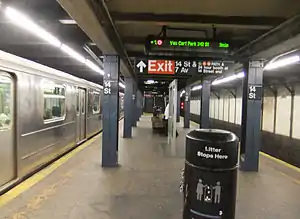 Uptown platform for local (right) and express trains (left) | |||||||||||||||||||||||||||||||||||||||||||||||||||||||||||||||||||||||||||||||||||||||||||||||||||||||||||||||||||||
| Station statistics | |||||||||||||||||||||||||||||||||||||||||||||||||||||||||||||||||||||||||||||||||||||||||||||||||||||||||||||||||||||
| Division | A (IRT) | ||||||||||||||||||||||||||||||||||||||||||||||||||||||||||||||||||||||||||||||||||||||||||||||||||||||||||||||||||||
| Line | IRT Broadway–Seventh Avenue Line | ||||||||||||||||||||||||||||||||||||||||||||||||||||||||||||||||||||||||||||||||||||||||||||||||||||||||||||||||||||
| Services | 1 2 3 | ||||||||||||||||||||||||||||||||||||||||||||||||||||||||||||||||||||||||||||||||||||||||||||||||||||||||||||||||||||
| Structure | Underground | ||||||||||||||||||||||||||||||||||||||||||||||||||||||||||||||||||||||||||||||||||||||||||||||||||||||||||||||||||||
| Platforms | 2 island platforms cross-platform interchange | ||||||||||||||||||||||||||||||||||||||||||||||||||||||||||||||||||||||||||||||||||||||||||||||||||||||||||||||||||||
| Tracks | 4 | ||||||||||||||||||||||||||||||||||||||||||||||||||||||||||||||||||||||||||||||||||||||||||||||||||||||||||||||||||||
| Other information | |||||||||||||||||||||||||||||||||||||||||||||||||||||||||||||||||||||||||||||||||||||||||||||||||||||||||||||||||||||
| Opened | July 1, 1918 | ||||||||||||||||||||||||||||||||||||||||||||||||||||||||||||||||||||||||||||||||||||||||||||||||||||||||||||||||||||
| Station code | 322[1] | ||||||||||||||||||||||||||||||||||||||||||||||||||||||||||||||||||||||||||||||||||||||||||||||||||||||||||||||||||||
| Accessible | not ADA-accessible; accessibility planned | ||||||||||||||||||||||||||||||||||||||||||||||||||||||||||||||||||||||||||||||||||||||||||||||||||||||||||||||||||||
| Opposite- direction transfer | Yes | ||||||||||||||||||||||||||||||||||||||||||||||||||||||||||||||||||||||||||||||||||||||||||||||||||||||||||||||||||||
| Station succession | |||||||||||||||||||||||||||||||||||||||||||||||||||||||||||||||||||||||||||||||||||||||||||||||||||||||||||||||||||||
| Next north | 34th Street–Penn Station (express): 2 18th Street (local): 1 | ||||||||||||||||||||||||||||||||||||||||||||||||||||||||||||||||||||||||||||||||||||||||||||||||||||||||||||||||||||
| Next south | Christopher Street–Sheridan Square (local): 1 Chambers Street (express): 2 | ||||||||||||||||||||||||||||||||||||||||||||||||||||||||||||||||||||||||||||||||||||||||||||||||||||||||||||||||||||
| |||||||||||||||||||||||||||||||||||||||||||||||||||||||||||||||||||||||||||||||||||||||||||||||||||||||||||||||||||||
| |||||||||||||||||||||||||||||||||||||||||||||||||||||||||||||||||||||||||||||||||||||||||||||||||||||||||||||||||||||
14th Street is an express station on the IRT Broadway–Seventh Avenue Line, consisting of four tracks and two island platforms.[19]
The track walls on both sides of the platform have their original IRT mosaic trim line with "14" tablets on it at regular intervals. Both platforms have blue I-beam columns that run along both sides at regular intervals with alternating ones having the standard black station name plate in white lettering.
Exits
This station has three fare control areas. The full-time entrance is at the north end. A single staircase from each platform leads to a crossover that has a newsstand in the center, two now defunct restrooms above the southbound platforms and tracks (mosaic signs reading "MEN" and "WOMEN" remain intact), and two full height turnstiles above the northbound platform and tracks (one entry/exit and one exit-only) leading to a staircase that goes up to the southeast corner of 14th Street and Seventh Avenue.[20] There is also a passageway leading to the BMT Canarsie platforms on Sixth Avenue, which in turn allows a free transfer to the IND Sixth Avenue Line platforms. The full-time turnstile bank at the center of the crossover opposite the newsstand leads to a mezzanine containing a token booth, three staircases going up to the either northern corners as well as the southwest corner of 14th Street and Seventh Avenue.[20] There is also a now-closed passageway with directional mosaics that leads to 14th Street/Eighth Avenue.
The station has an exit-only area at the center. Two staircases from each platform go up to a crossover where on either side, a single exit-only turnstile and emergency gate leads to a staircase that goes up to either northern corners of 13th Street and Seventh Avenue.[20]
The station has an unstaffed fare control area at the south end. A single staircase from each platform leads to a crossover and a bank of turnstiles as well as one exit-only and one full-height turnstile. The mezzanine has a now-unused customer assistance booth and two staircases going up to both northern corners of 12th Street and Seventh Avenue.[20]
IND Sixth Avenue Line platforms
14 Street | ||||||||||||||||||||||||||||||||||||||||||||||||||||||||||||||||||||||||||||||||||||||||||||||||
|---|---|---|---|---|---|---|---|---|---|---|---|---|---|---|---|---|---|---|---|---|---|---|---|---|---|---|---|---|---|---|---|---|---|---|---|---|---|---|---|---|---|---|---|---|---|---|---|---|---|---|---|---|---|---|---|---|---|---|---|---|---|---|---|---|---|---|---|---|---|---|---|---|---|---|---|---|---|---|---|---|---|---|---|---|---|---|---|---|---|---|---|---|---|---|---|---|
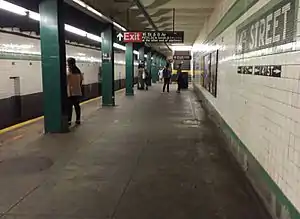 Southbound platform | ||||||||||||||||||||||||||||||||||||||||||||||||||||||||||||||||||||||||||||||||||||||||||||||||
| Station statistics | ||||||||||||||||||||||||||||||||||||||||||||||||||||||||||||||||||||||||||||||||||||||||||||||||
| Division | B (IND) | |||||||||||||||||||||||||||||||||||||||||||||||||||||||||||||||||||||||||||||||||||||||||||||||
| Line | IND Sixth Avenue Line | |||||||||||||||||||||||||||||||||||||||||||||||||||||||||||||||||||||||||||||||||||||||||||||||
| Services | F M | |||||||||||||||||||||||||||||||||||||||||||||||||||||||||||||||||||||||||||||||||||||||||||||||
| Platforms | 2 side platforms | |||||||||||||||||||||||||||||||||||||||||||||||||||||||||||||||||||||||||||||||||||||||||||||||
| Tracks | 2 | |||||||||||||||||||||||||||||||||||||||||||||||||||||||||||||||||||||||||||||||||||||||||||||||
| Other information | ||||||||||||||||||||||||||||||||||||||||||||||||||||||||||||||||||||||||||||||||||||||||||||||||
| Opened | December 15, 1940 | |||||||||||||||||||||||||||||||||||||||||||||||||||||||||||||||||||||||||||||||||||||||||||||||
| Station code | 229[1] | |||||||||||||||||||||||||||||||||||||||||||||||||||||||||||||||||||||||||||||||||||||||||||||||
| Accessible | not ADA-accessible; accessibility planned | |||||||||||||||||||||||||||||||||||||||||||||||||||||||||||||||||||||||||||||||||||||||||||||||
| Opposite- direction transfer | Yes | |||||||||||||||||||||||||||||||||||||||||||||||||||||||||||||||||||||||||||||||||||||||||||||||
| Station succession | ||||||||||||||||||||||||||||||||||||||||||||||||||||||||||||||||||||||||||||||||||||||||||||||||
| Next north | 23rd Street: F | |||||||||||||||||||||||||||||||||||||||||||||||||||||||||||||||||||||||||||||||||||||||||||||||
| Next south | West Fourth Street–Washington Square: F | |||||||||||||||||||||||||||||||||||||||||||||||||||||||||||||||||||||||||||||||||||||||||||||||
| ||||||||||||||||||||||||||||||||||||||||||||||||||||||||||||||||||||||||||||||||||||||||||||||||
| ||||||||||||||||||||||||||||||||||||||||||||||||||||||||||||||||||||||||||||||||||||||||||||||||
14th Street is a local station on the IND Sixth Avenue Line, and has two side platforms to the inside of the tracks. Both platforms have a green trim line on a darker green border and name tablets reading "14TH STREET" in white sans serif lettering on a dark green background and a lighter green border. Beneath the trim line and name tablets are small directional and number signs in white numbering on a black background. Trains open their doors to the left in both directions, which is unusual for a side platformed station in New York City. Most side platforms in the system are to the outside of the tracks and thus trains open the doors to the right. The PATH tracks and platforms are located between the two Sixth Avenue Line platforms, on the other side of the platform walls, and are not visible from this station.[18]
The Sixth Avenue express tracks are at a lower level beneath the PATH tracks and thus not visible from this station either. The deep-bore tunnel's round shape becomes square below this station and at 23rd Street, where provisions for lower level platforms were built.
There is a full length mezzanine over the platforms and tracks that is largely unused and dimly lit.[18]
Exits
There are entrance/exits at both 14th Street and 16th Street, with fare controls at both ends. The 14th Street entrance is shared with the PATH station of the same name, which has a separate fare control.[20] At both intersections, exits lead to all four corners.[20] At the extreme south end of each platform, there is a single-wide stairway descending to the Canarsie Line platform.
BMT Canarsie Line platform
6 Avenue | |||||||||||||||||||||||||||||||||||||||||||||||||||||||||||||||||||||||||||
|---|---|---|---|---|---|---|---|---|---|---|---|---|---|---|---|---|---|---|---|---|---|---|---|---|---|---|---|---|---|---|---|---|---|---|---|---|---|---|---|---|---|---|---|---|---|---|---|---|---|---|---|---|---|---|---|---|---|---|---|---|---|---|---|---|---|---|---|---|---|---|---|---|---|---|---|
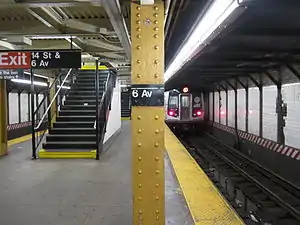 | |||||||||||||||||||||||||||||||||||||||||||||||||||||||||||||||||||||||||||
| Station statistics | |||||||||||||||||||||||||||||||||||||||||||||||||||||||||||||||||||||||||||
| Division | B (BMT) | ||||||||||||||||||||||||||||||||||||||||||||||||||||||||||||||||||||||||||
| Line | BMT Canarsie Line | ||||||||||||||||||||||||||||||||||||||||||||||||||||||||||||||||||||||||||
| Services | L | ||||||||||||||||||||||||||||||||||||||||||||||||||||||||||||||||||||||||||
| Structure | Underground | ||||||||||||||||||||||||||||||||||||||||||||||||||||||||||||||||||||||||||
| Platforms | 1 island platform | ||||||||||||||||||||||||||||||||||||||||||||||||||||||||||||||||||||||||||
| Tracks | 2 | ||||||||||||||||||||||||||||||||||||||||||||||||||||||||||||||||||||||||||
| Other information | |||||||||||||||||||||||||||||||||||||||||||||||||||||||||||||||||||||||||||
| Opened | June 30, 1924 | ||||||||||||||||||||||||||||||||||||||||||||||||||||||||||||||||||||||||||
| Station code | 116[1] | ||||||||||||||||||||||||||||||||||||||||||||||||||||||||||||||||||||||||||
| Accessible | not ADA-accessible; accessibility planned | ||||||||||||||||||||||||||||||||||||||||||||||||||||||||||||||||||||||||||
| Opposite- direction transfer | Yes | ||||||||||||||||||||||||||||||||||||||||||||||||||||||||||||||||||||||||||
| Station succession | |||||||||||||||||||||||||||||||||||||||||||||||||||||||||||||||||||||||||||
| Next west | Eighth Avenue: L | ||||||||||||||||||||||||||||||||||||||||||||||||||||||||||||||||||||||||||
| Next east | Union Square: L | ||||||||||||||||||||||||||||||||||||||||||||||||||||||||||||||||||||||||||
| |||||||||||||||||||||||||||||||||||||||||||||||||||||||||||||||||||||||||||
| |||||||||||||||||||||||||||||||||||||||||||||||||||||||||||||||||||||||||||
Sixth Avenue on the BMT Canarsie Line has one island platform and two tracks and is approximately 40 feet (12 m) below street level.

Both track walls have their original mosaic trim line consisting of earthy tones of olive green, brown, ochre and tan augmented by light green and Copenhagen blue. "6" tablets representing "Sixth Avenue" run along the trim line at regular intervals.[21]
The 1993 artwork here is called MTA Jewels by Jennifer Kotter.[22] It consists of paintings of various subjects on the passageway leading to the IRT.
West of the station, a center lay-up track begins at a bumper block and is only accessible from the Eighth Avenue terminal. This station was the terminal for the BMT Canarsie Line until the Eighth Avenue station opened in 1931.
Exits
The station has seven staircases going up from the platform. The two westernmost ones go up to a passageway that leads to the full-time fare control area at the IRT Broadway–Seventh Avenue Line station. The next two go up to the extreme south ends of either platform of the IND Sixth Avenue Line station. The western staircase goes to the southbound platform, and the one directly east of it goes to the northbound platform
The next two staircases go up to a mezzanine leading to fare control that has a powder blue and state blue trim line. A bank of three regular turnstiles and two high entry/exit turnstiles provide entrance/exit from the station and there is no token booth. Two staircases go up to either eastern corners of 14th Street and Sixth Avenue.[20] Another unstaffed bank of turnstiles by the northeast staircase leads to the mezzanine above the Queens-bound platform of 14th Street on the IND.[20]
The last staircase on the extreme east end of the platform leads to a storage area and ventilation room. Another staircase in this section has been removed.
In popular culture
Starting roughly at the 27-minute mark in the 1977 film Joy, the title character, portrayed by Sharon Mitchell, enters the Sixth Avenue station, then boards a train car on which she seduces the only other passenger on the train.
Image gallery
 Mosaic decoration with number "14" in the tile borders
Mosaic decoration with number "14" in the tile borders Mezzanine area
Mezzanine area Mosaics above the former men's restroom
Mosaics above the former men's restroom.jpg.webp) Trim line and name tablet
Trim line and name tablet Northwest stair of PATH leading to the station
Northwest stair of PATH leading to the station_by_David_Shankbone.jpg.webp) Musician playing on the southbound IND platform
Musician playing on the southbound IND platform
References
- "Station Developers' Information". Metropolitan Transportation Authority. Retrieved June 13, 2017.
- "Facts and Figures: Annual Subway Ridership 2014–2019". Metropolitan Transportation Authority. 2020. Retrieved May 26, 2020.
- "Terms and Conditions of Dual System Contracts". nycsubway.org. Public Service Commission. March 19, 1913. Retrieved February 16, 2015.
- "The Dual System of Rapid Transit (1912)". nycsubway.org. Public Service Commission. September 1912. Retrieved May 30, 2017.
- "Most Recent Map of the Dual Subway System WhIch Shows How Brooklyn Borough Is Favored In New Transit Lines". The Brooklyn Daily Eagle. September 9, 1917. p. 37. Retrieved August 23, 2016 – via Brooklyn Newspapers.
- Engineering News-record. 75. McGraw-Hill Publishing Company. 1916. p. 846.
- Whitney, Travis H. (March 10, 1918). "The Seventh and Lexington Avenue Subways Will Revive Dormant Sections — Change in Operation That Will Transform Original Four-Tracked Subway Into Two Four-Tracked Systems and Double Present Capacity of the Interborough" (PDF). The New York Times. p. 12. Retrieved August 26, 2016.
- "Public Service Commission Fixes July 15 For Opening of The New Seventh and Lexington Avenue Subway Lines" (PDF). The New York Times. May 19, 1918. p. 32. Retrieved November 6, 2016.
- "Open New Subway to Regular Traffic" (PDF). The New York Times. July 2, 1918. p. 11. Retrieved November 6, 2016.
- "Open New Subway Lines to Traffic; Called a Triumph" (PDF). The New York Times. August 2, 1918. p. 1. ISSN 0362-4331. Retrieved April 21, 2020.
- "Subway Tunnel Through - Passage Under East River in East 14th Street Line Complete" (PDF). The New York Times. August 8, 1919. Retrieved February 28, 2010.
- "Celebrate Opening of Subway Link" (PDF). The New York Times. July 1, 1924. p. 23. Retrieved February 13, 2010.
- "New Subway Line on 6th Ave. Opens at Midnight Fete" (PDF). The New York Times. December 15, 1940. p. 1. Retrieved October 7, 2011.
- "Add 3 Subway Transfers". New York Daily News. January 16, 1978. Retrieved November 6, 2018.
- "ADA Accessibility at 14 Street - 6 Avenue / 7 Avenue Station Complex - Design Only - Capital Plan 2015 - 2019". mta.info. Metropolitan Transportation Authority. Archived from the original on May 5, 2020. Retrieved November 18, 2018.
- Berger, Paul (June 26, 2018). "MTA Postpones Platform-Safety Pilot Program". Wall Street Journal. ISSN 0099-9660. Retrieved June 26, 2018.
- "Elevators are a win, but L-train shutdown fight still on track". The Villager Newspaper. June 21, 2018. Archived from the original on May 5, 2020. Retrieved June 26, 2018.
- "IND 6th Avenue Line". NYC Subway. Retrieved May 6, 2020.
- "Open New Subway to Regular Traffic; First Train on Seventh Avenue Line Carries Mayor and Other Officials ... New Extensions of Elevated Railroad Service … Currents of Travel to Change" (PDF). The New York Times (July 2, 1918). July 2, 1918. p. 11. Retrieved April 23, 2015.
- "MTA Neighborhood Maps: Chelsea" (PDF). mta.info. Metropolitan Transportation Authority. 2018. Retrieved October 1, 2018.
- "BMT Canarsie Line". NYC Subway. Retrieved May 6, 2020.
- "Artwork: MTA Jewels (Jennifer Kotter)". NYC Subway. Retrieved May 6, 2020.
External links
| Wikimedia Commons has media related to 14th Street (IND Sixth Avenue Line). |
- nycsubway.org – IRT West Side Line: 14th Street (Seventh Avenue)
- nycsubway.org – BMT Canarsie Line: 6th Avenue
- nycsubway.org – IND 6th Avenue: 14th Street (Sixth Avenue)
- Station Reporter — 14th Street/6th and 7th Avenue Complex
|
| |||||||||||||||||||||||



